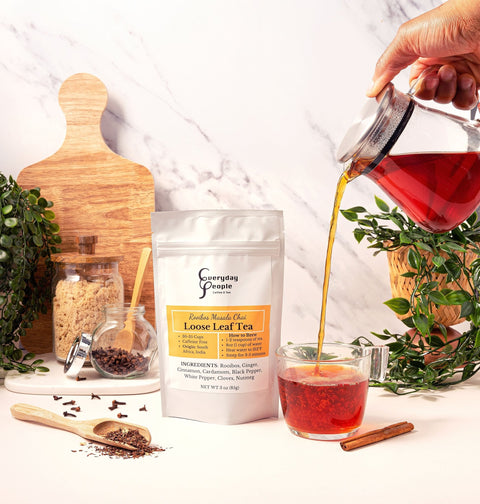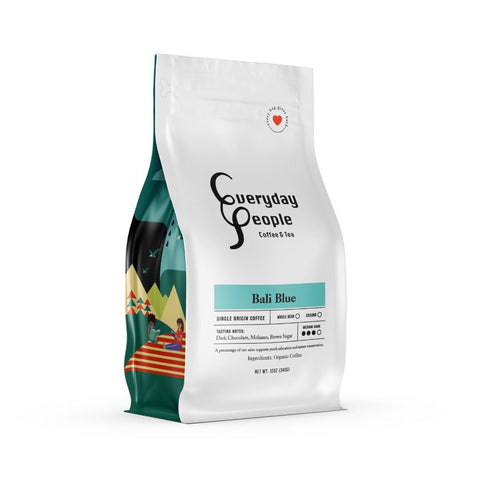For dedicated coffee drinkers, the idea of exploring tea might seem like venturing into unfamiliar territory. After all, when you've perfected your morning espresso ritual or discovered the perfect pour-over technique, why venture beyond what you know and love?
The answer, as thousands of coffee lovers discover each year, is far more complex and rewarding than most expect. Tea offers an entirely different yet complementary world of flavor, craftsmanship, and daily ritual that enhances rather than replaces your coffee appreciation. This beginner's guide to tea explores how tea for coffee drinkers can open entirely new dimensions of taste, energy, and satisfaction—using the sophisticated palate and brewing knowledge you've already developed.
The Great Divide That Isn't Really There

Walk into any specialty coffee shop today and you'll likely find a carefully curated tea selection alongside the single-origin espressos. This isn't coincidence. The same appreciation for origin, processing, and brewing precision that defines coffee culture translates beautifully to tea. Both beverages demand attention to detail, reward curiosity, and offer endless opportunities for discovery.
Coffee drinkers already possess sophisticated palates trained to detect subtle differences in flavor, acidity, and body. These sensory skills transfer directly to tea appreciation, often making coffee enthusiasts some of the most discerning tea drinkers.
The numbers support this crossover appeal. According to recent industry data, 67% of specialty coffee drinkers now regularly consume tea, and the overlap continues growing as more people discover that loving both beverages isn't just possible—it's natural.
Understanding Your Coffee Palate's Tea Counterparts
If you can distinguish between a bright Ethiopian Yirgacheffe and a rich Colombian Huila, you already have the foundational skills for navigating tea's diverse landscape. The key is understanding how familiar coffee characteristics translate to tea.
Bold and full-bodied coffee lovers typically gravitate toward robust black teas. Assam, grown in India's northeastern region, delivers the malty richness that satisfies those who prefer dark roasts. English Breakfast blends offer familiar strength with approachable complexity. These teas can handle milk and sugar, making the transition from coffee shop lattes surprisingly seamless.
Bright, acidic coffee enthusiasts often find their match in Ceylon teas from Sri Lanka's high-altitude gardens. These teas provide citrusy brightness reminiscent of East African coffees, with clean finishes that refresh rather than overwhelm.
Those drawn to complex, wine-like coffees discover oolong teas offer similar intricacy. Taiwanese high-mountain oolongs, in particular, present layers of flavor that evolve with each sip, much like the best natural-process coffees reveal different notes as they cool.
The Science of Satisfaction
What makes tea particularly appealing to coffee drinkers goes beyond flavor. The caffeine in tea behaves differently than coffee's quick-acting buzz. Tea contains L-theanine, an amino acid that creates a different type of alertness experience. This combination creates what researchers call "relaxed focus" sustained energy with a different character than coffee.
For detailed comparisons of how different teas and coffees affect your energy levels, our coffee vs. tea caffeine guide breaks down the specifics of timing, intensity, and duration.
Mastering Loose Leaf Tea Basics
Understanding loose leaf tea basics requires unlearning some coffee habits while building on others. Water quality matters as much for tea as coffee—perhaps more. But where coffee generally uses near-boiling water, tea demands precision temperature control that varies by type.
Consider temperature the way you'd consider grind size for coffee: essential and non-negotiable for optimal extraction. Black teas can handle boiling water, but green teas require cooler temperatures around 175°F to avoid bitterness. Oolong teas fall somewhere between, typically brewing best around 190-200°F.
Timing matters differently too. Where coffee extraction happens in seconds or minutes depending on method, tea steeping ranges from two minutes for delicate greens to five minutes for robust blacks. Unlike over-extracted coffee, which becomes bitter and unpleasant, over-steeped tea simply becomes stronger—though each variety has its optimal range.
The equipment investment starts minimal. A simple infuser, variable temperature kettle, and timer provide everything needed for excellent results. As interest grows, dedicated teapots, gaiwans, and other brewing vessels offer new dimensions of control and experience.
Regional Stories in Every Cup
Just as coffee tells stories of specific farms, altitudes, and processing methods, tea carries the narrative of its origin. Chinese Keemun black tea delivers malty sweetness with wine-like complexity, reflecting centuries of refined processing techniques. Indian Darjeeling offers muscatel notes in its second flush, harvested during specific weeks when mountain conditions create perfect grape-like characteristics.
Japanese green teas showcase terroir as distinctly as any coffee. Sencha from Shizuoka Prefecture presents grassy freshness that speaks to volcanic soil and coastal climate. Matcha from Uji demonstrates how shading, stone-grinding, and ceremonial tradition create flavors impossible to replicate elsewhere.
These origin stories matter because they help coffee drinkers apply existing knowledge to new experiences. Understanding that Ceylon grows at high altitude explains its bright acidity. Knowing that Assam's lowland climate produces robust flavors provides context for its strength.
Building Your Tea Routine
The most successful transitions from coffee to tea happen gradually. Rather than replacing morning coffee—often a non-negotiable ritual—most people find success introducing tea during other parts of the day.
Mid-morning tea breaks work particularly well. Around 10 AM, when the first coffee's effects begin waning, a cup of Earl Grey or Darjeeling provides a different energy experience. This timing allows appreciation for tea's gentler energy curve while maintaining beloved morning coffee traditions.
Afternoon tea sessions offer perhaps the most natural entry point. Between 2-4 PM, when coffee might feel too intense, tea provides a different option. Green teas work especially well here, offering alertness with a different character.
Evening herbal teas introduce caffeine-free options that complement rather than compete with coffee. Chamomile, peppermint, and rooibos create wind-down rituals that bookend days begun with coffee's energizing start.
Curated Discovery Through Tea Bundles

Starting a tea journey can feel overwhelming given the thousands of available options. Curated bundles solve this problem by providing structured exploration based on coffee preferences and experience levels.
Coffee Drinker Starter Sets typically include representative examples from major tea categories: a robust black tea for familiar strength, a quality green tea for exploring lighter flavors, an oolong for complexity appreciation, and an herbal option for evening enjoyment. These collections provide comparison points while ensuring variety.
Regional Focus Bundles appeal to coffee drinkers who enjoy exploring specific origins. A Chinese tea collection might include Keemun black, Longjing green, Tieguanyin oolong, and jasmine-scented tea, providing comprehensive regional perspective similar to single-origin coffee flights.
Processing Method Collections demonstrate how the same leaves create different experiences through varied handling, much like how processing affects coffee flavor development. These bundles help coffee drinkers understand tea's equivalent to washed versus natural processing.
Our tea collection page offers several bundles designed specifically for different experience levels and preference profiles.
Advanced Appreciation
As tea knowledge develops, coffee drinkers often discover parallels to specialty coffee's depth. Aged pu-erh teas develop complexity over decades, similar to how certain coffees improve with proper storage. Single-estate teas showcase specific terroir characteristics just as single-origin coffees highlight unique growing conditions.
Brewing methods expand beyond simple steeping. Gongfu brewing—using small vessels and multiple short steeps—reveals tea's evolution through successive infusions. This technique parallels coffee cupping in revealing subtle characteristics often missed in standard preparation.
Tea tastings follow similar protocols to coffee cuppings, evaluating dry leaf appearance, wet leaf aroma, liquor color, taste, and finish. These structured approaches help coffee drinkers apply existing sensory skills to tea evaluation.
Embracing Both Worlds
The journey from coffee appreciation to tea understanding doesn't require choosing sides. Most enthusiasts find that exploring tea actually deepens coffee appreciation by expanding sensory awareness and brewing precision. Both beverages reward attention, celebrate origin, and provide daily rituals that enhance life quality.
Tea for coffee drinkers represents expansion rather than replacement. Morning coffee can coexist beautifully with afternoon tea, creating complementary beverage experiences that enhance daily routines and provide variety throughout the day.
The crossover continues growing as more coffee shops add serious tea programs and tea companies recognize coffee drinkers as natural customers. This convergence benefits everyone, creating more sophisticated beverage culture and greater appreciation for both traditions.
Your Journey Forward
Starting your tea exploration doesn't require dramatic changes or expensive investments. Begin with quality examples from major categories, focus on proper brewing techniques, and allow preferences to develop naturally. Track what you enjoy, much like coffee tasting notes, and let curiosity guide discovery.
Consider a tea subscription service for ongoing exploration. These programs introduce new teas monthly, providing structure for systematic learning while ensuring variety that prevents boredom.
Remember that developing tea appreciation, like coffee expertise, takes time. Allow your palate to adjust to new flavor profiles and brewing methods. The investment in learning pays dividends in expanded enjoyment and deeper beverage understanding.
Your coffee expertise provides the perfect foundation for tea exploration. The skills you've developed—attention to detail, appreciation for quality, understanding of how preparation affects flavor—transfer directly to tea. What awaits is not a replacement for coffee passion, but an expansion of it into new territories of flavor, culture, and satisfaction.
The world of tea offers lifetime exploration opportunities. From ancient Chinese traditions to innovative modern blends, from simple daily rituals to elaborate ceremonies, tea provides endless avenues for discovery. For coffee lovers willing to expand their horizons, this journey promises rewards as rich and satisfying as the best espresso shot—just different, complementary, and equally worthy of devotion.





